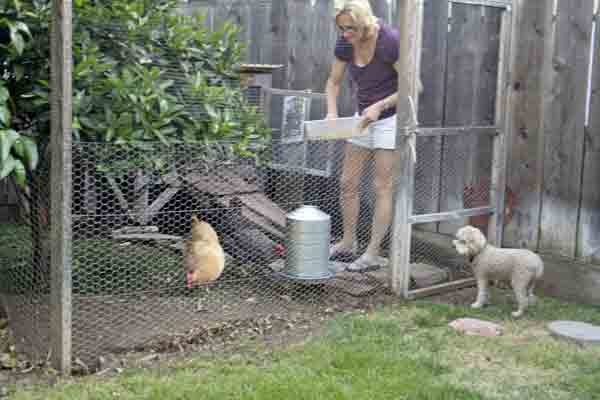Backyard chickens are pets with perks. Laying hens provide a steady supply of fresh, organic eggs; unusual breeds can satisfy birdwatchers' desire to observe an animal exploring its surroundings; and poultry manure is an excellent soil amendment.
Surprisingly, chickens are pretty good companion animals as well. My family keeps two chickens in a 10-foot-square pen in the side yard of our tract home. The birds are as thrilled to see us at the end of the day as our dog and cats. They provide enough eggs for us to share with neighbors and, as one might expect, their food expenses amount to chicken feed.
Chicken rearing in urban areas seems to be keeping pace with growing interest in gardening. Among the California cities that permit backyard chickens are San Francisco, Anaheim, Long Beach, Oakland, Bakersfield and San Diego. Last summer, the Sacramento City Council passed an ordinance that allows citizens to raise up to three chickens in their backyards. Before bringing home chickens, check to see whether they are permitted under local ordinances where you live.
UC Cooperative Extension offers resources on selecting and caring for chickens. A free pamphlet, Selecting Chickens for Home Use, has guidelines for people who want chickens for eggs, meat or exhibition stock.
The best egg-laying breeds, the authors say, are Rhode Island Red, New Hampshire Red and Single-Comp White Leghorn. Characteristics sought for meat producers include fast growth and efficient feed utilization. The most common meat chicken is a cross between White Plymouth Rock hens and White Cornish cocks.
Chicken rearing is a popular 4-H project that goes back to the inception of the program in California nearly 100 years ago. At the outset, UC Cooperative Extension 4-H placed a heavy emphasis on farm production and farm family activities. As the state became increasingly urban and suburban, the scope of 4-H expanded into such projects as recycling, robotics, foods and nutrition and leadership. Now that popular culture is turning Californians back to rural roots - raising chickens and tending vegetable gardens - 4-H is uniquely poised to show them how.
The California 4-H Poultry Project Sheet can be used to engage children in raising backyard chickens, whether they are enrolled in 4-H or not. The National 4-H poultry curriculum details the responsible and humane care and raising of chickens. It outlines the the best management practices used on farms and in industry and the value of poultry meat and eggs in human nutrition.
The 4-H poultry curriculum is available for a nominal cost in the 4-H online store.
Get more information about enrolling in 4-H on the UC 4-H Youth Development Program website.
Attached Images:
